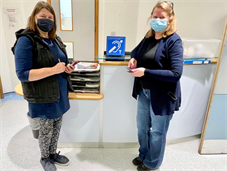Hearing loops updated at the Trust to aid deaf patients
05 May 2022 - The hearing loops will help patients who are deaf/have hearing loss engage in face-to-face communication with staff

This week, King’s College Hospital, Denmark Hill, has launched updated hearing loops for patients and visitors who are deaf or have hearing loss.
The loops are an assistive listening technology providing the accessibility many who wear compatible hearing aids need to engage in face-to-face communication.
King’s patients Penelope Beschizza and Helen Cherry, members of the King’s Patients Accessibility Advisory Group, helped with the launch of the updated hearing loops.
“As a deaf person, patient, and someone who cared for my late husband at King’s who was deaf, being involved with the hearing loop project makes me feel valued.” Penelope said. “It’s great to see the hospital is using real deaf/hearing aid users in the process.
“We hope that through our deaf user and staff collaboration, the reception staff are more aware of clearer communication with deaf patients and visitors.”
Helen Cherry added: “This is a positive step in the right direction to enable inclusive access.
“In this era of wearing masks and not being able to see faces to lip read, having use of induction loops means I can switch my aids to the T switch which enables a directional audio of the spoken word to be streamed direct to my aids. This does not mean I can hear every word, but it does assist me in capturing more meaning of what is being said.”
The hearing loops are located on the reception desks in the main reception and in Outpatient Departments at King’s College Hospital, and can be used by patients by switching their hearing aid to the T setting.
The updated loops help us to better support patients who are deaf or have hearing loss and help us to provide more inclusive care to our patients – one of the four components of our BOLD vision.
Read more on how King’s is meeting the Accessible Information Standard (AIS) to offer reasonable adjustments to help people who have a disability, impairment or sensory loss.
